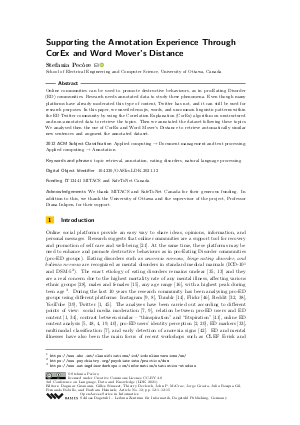@InProceedings{pecore:OASIcs.LDK.2021.12,
author = {Pec\`{o}re, Stefania},
title = {{Supporting the Annotation Experience Through CorEx and Word Mover’s Distance}},
booktitle = {3rd Conference on Language, Data and Knowledge (LDK 2021)},
pages = {12:1--12:15},
series = {Open Access Series in Informatics (OASIcs)},
ISBN = {978-3-95977-199-3},
ISSN = {2190-6807},
year = {2021},
volume = {93},
editor = {Gromann, Dagmar and S\'{e}rasset, Gilles and Declerck, Thierry and McCrae, John P. and Gracia, Jorge and Bosque-Gil, Julia and Bobillo, Fernando and Heinisch, Barbara},
publisher = {Schloss Dagstuhl -- Leibniz-Zentrum f{\"u}r Informatik},
address = {Dagstuhl, Germany},
URL = {https://drops.dagstuhl.de/entities/document/10.4230/OASIcs.LDK.2021.12},
URN = {urn:nbn:de:0030-drops-145481},
doi = {10.4230/OASIcs.LDK.2021.12},
annote = {Keywords: topic retrieval, annotation, eating disorders, natural language processing}
}

 Creative Commons Attribution 4.0 International license
Creative Commons Attribution 4.0 International license








































